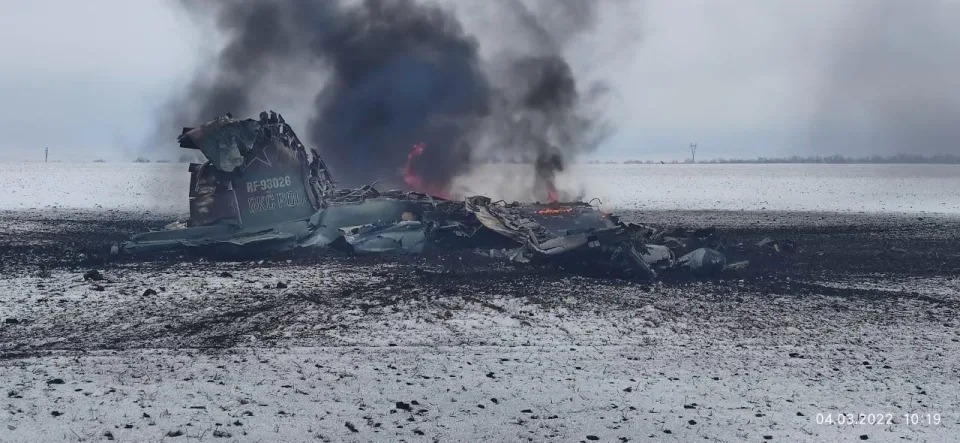Business Insider
The Russian air force’s struggles in Ukraine are surprising because they’re fighting ‘their own systems,’ top US Air Force general says
Christopher Woody – June 22, 2022

- Russia’s inability to achieve air superiority is one of the biggest surprises of the war in Ukraine.
- Russia’s air force has been unable to ground Ukrainian aircraft or overcome Ukrainian air defenses.
- That’s surprising because they use some of the same equipment, Gen. Charles Brown Jr. said Wednesday.
The Russian air force’s failure to gain control of the air over Ukraine and its struggles to operate effectively against Ukrainian air defenses are among the biggest surprises in the four-month war.
Russia’s failure to ground Ukraine’s aircraft and to overcome Ukrainian anti-aircraft weapons contributed to the faltering of Moscow’s initial ground offensive — an unusual outcome because the Russians themselves use many of the same weapons, according to Gen. Charles Brown Jr., the chief of staff of the US Air Force.
“I think for me it’s surprising for the Russians because the systems they’re going against are their own systems. They should know them fairly well and how to defeat them,” Brown said Wednesday at the Hudson Institute, a think tank in Washington DC.
“It kind of begs a real question for me: How come they don’t understand their own systems and how they might defeat their own systems?” Brown added.

Like other former Soviet republics, Ukraine still uses Soviet-origin military hardware. Among its fixed-wing fleet are Su-24 and Su-25 attack aircraft and MiG-29 and Su-27 fighter jets.
The Russian military operates upgraded versions of those jets as well as more advanced fighter and attack jets, many of which were deployed near Ukraine’s borders prior to Russia’s attack on February 24.
Ukraine also operates Soviet- or Russian-origin air-defense systems and missiles, some of which were donated by neighboring countries. It has also shot down Russian aircraft with the Soviet-designed S-300 air-defense system, the vulnerabilities of which should be well known to Russian mission planners and pilots. Ukrainians have also captured Russian anti-aircraft weapons.
Like the Soviet-made aircraft operated by some NATO member militaries, Ukraine’s jets and helicopters are aging and finding spare parts and expertise to keep them in operation has grown harder as time passes and tensions have risen.
Ukrainians have repeatedly asked the US and others to provide advanced Western-made fighter jets, but those countries have declined due to concerns about escalation with Russia and doubts about Ukraine’s ability to use them effectively.

The absence of large-scale Russian air operations in Ukraine perplexed observers and led analysts to conclude that Russia’s air force was not as capable as believed. Russian failure to suppress and destroy Ukrainian air defenses is also seen as a major shortcoming that has reduced Russian ground forces’ ability to seize territory rapidly.
In his remarks Wednesday, Brown contrasted Russia’s performance in Ukraine with the US military’s emphasis on achieving air superiority, pointing to US air operations against Iraq during the first Gulf War of 1991.
“We were able to take out many of the surface-to-air defense systems to clear areas so then we could provide air superiority over the areas where the ground forces were operating,” Brown said. “That’s not the way the Russians have operated. They really haven’t looked at suppressing air defense.
Russian air power has moved closer to where Russian troops have superiority on the ground, Brown added. “They kind of stuck to where they were overhead of where their ground forces were [and] wouldn’t venture very far because of what the Ukrainians were able to do with their air defenses.”
Brown credited the Ukrainians for being “fairly dynamic” with their air-defense systems, which have been bolstered by thousands of portable weapons, including US-made Stinger missiles, supplied by NATO countries.

Being dynamic has “made it more difficult” for the Russians, Brown said. “If you can’t do dynamic targeting very well, you’re going to have a hard time hitting moving targets. That’s something I think we do fairly well and it’s something we’re going to continue to work on.”
While losses on both sides are unclear, Ukraine said in mid-May that it had destroyed 200 Russian aircraft.
Russia appears to have reduced its ambitions in Ukraine in recent weeks, focusing on operations in eastern Ukraine and using bombardment by long-range artillery and other weapons to overwhelm Ukrainian positions.
Eastern Ukraine’s geography is less hospitable to Ukrainian aircraft and air defenses and will likely allow Russia to gain some local air superiority, but shortages of weapons and equipment for close air support and a lack of training for that complicated mission will limit Russia’s ability to exploit that advantage, according to Justin Bronk, an expert on air warfare at British defense think tank RUSI.
